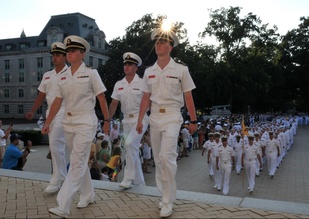
Shepherd and Horner (2010) used the LID model in their discussion of leadership at institutions of the United States government where formal, intensive leader development is at the heart of the mission: the Naval Academy in Annapolis, the Military Academy at West Point, the Air Force Academy in Colorado, and the Coast Guard Academy in Connecticut. They studied leadership at “a highly selective, East Coast military college” following students from their first year through their senior year.
Shepherd and Horner described leader development at the service academies as being hierarchical and consistent with the LID model. During the first year the emphasis is on self-leadership, learning to follow orders, learning teamwork, and understanding the culture. In the second year students supervise the new first year students and help them learn professional knowledge. After two years, most students will have reached the LID stage of Generality where they are developing an understanding of the greater good and a better understanding of the potential of leadership to effect change. During these last two years students assume even greater responsibilities leading other students through actions and as role models. Their focus moves from the individual level to the organizational level. Leadership is internalized and each student develops a model of his or her own leadership identity. This hierarchical system is common to all service academies.
Shepherd and Horner’s study asked what is the best predictor of leadership ability, which they defined as aptitude for commissioning as a military officer. This aptitude is measured each semester. What has the greatest impact on this measure of leader ability? Was it GPA? Athletic participation? Years at the academy? Or peer rankings?
Their finding: “Consistent with industrial-era leadership studies, there is sufficient evidence to support the argument that ranking by one’s peers continues to be a significant indicator of an individual’s leadership development” (p. 26). There was no close second.
My take-aways:
(1) Leadership is about relationships. The service academies are unique. Students rating each other live with each other in a relatively closed environment nearly 24/7. Even here though, there will be different levels of relationships. Different types of situational leaders may be masked. But overall, who best to assess leadership potential than those who work and live with each other? How do you see the leader potential of those around you? How do they see your leader potential? Regardless of whether or not you are actually in a leadership position, are you perceived as a leader?
(2) Shepherd and Horner’s study underscores the importance of peer feedback. Add in feedback from direct reports and supervisors and a good case can be made for 360 degree feedback. But a caveat, if trust is not part of the culture, 360 degree feedback may be problematic. Do you have those you trust who can give you honest feedback? Do you ask for that feedback? If so, do you use that feedback to grow as a leader?
(3) A self inventory of our relationships and how others see us may be a good exercise. Where are our relationships strong? Where do we need to reach out and build new or better relationships?
(4) The service academies have a structure that allows educators to construct intense leadership experiences and opportunities for young men and women. Do all become leaders? Probably not. But I would venture the academies as leadership laboratories produce their fair share for our nation’s future.
Sheperd, R. S., & Horner, D. H., Jr. (2010). Indicators of leadership development in undergraduate military education. Journal of Leadership Studies, 4 (2), 18-29.
U.S. Navy photo by Mass Communication Specialist 2nd Class Julia A. Casper/Released. https://www.flickr.com/photos/usnavy/9194221810/in/photostream/
Used with permission: https://creativecommons.org/licenses/by/2.0/deed.en
 RSS Feed
RSS Feed